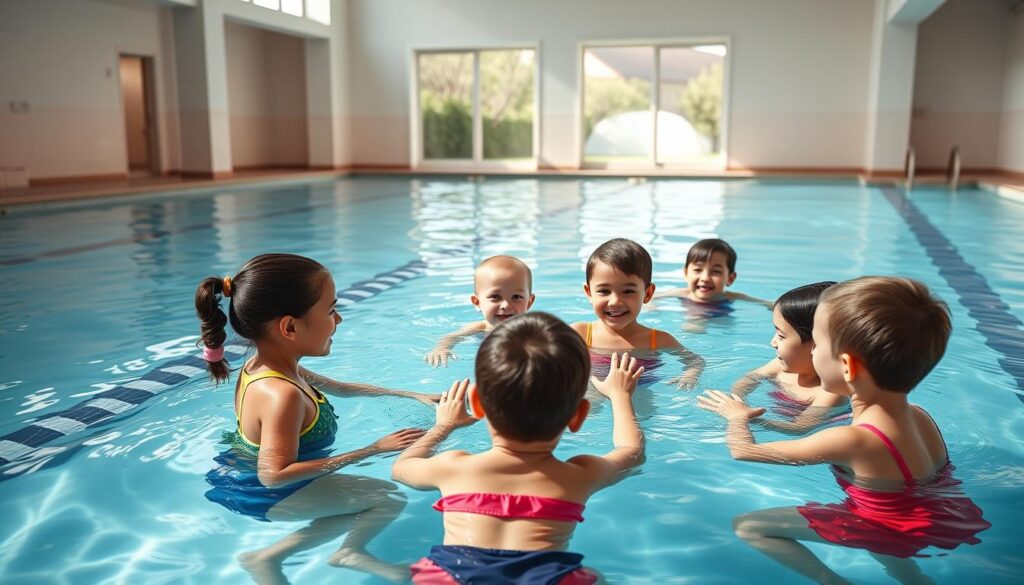Have you ever wondered why swim lessons are considered a foundational life skill for children? Beyond the fun of splashing in the pool, learning to swim builds confidence, enhances physical health, and equips kids with critical water safety skills. Starting early can make a world of difference.
The American Academy of Pediatrics (AAP) recommends beginning swim lessons as early as age one. Early exposure not only improves muscle strength and coordination but also supports cognitive development. Swimming is a low-impact exercise that boosts cardiovascular health while fostering social skills through group activities.
Whether it’s mastering floating or treading water, the process is about patience and practice. Structured environments, like professional classes, combined with at-home reinforcement, ensure steady progress. Every child develops at their own pace, so it’s essential to create a supportive and fun learning experience.
Key Takeaways
- Swim lessons are vital for water safety and skill development.
- The AAP suggests starting lessons between ages one and four.
- Swimming enhances physical health, coordination, and social skills.
- Patience and structured environments are key to success.
- Supplement formal classes with at-home practice for better results.
Why Teaching Kids to Swim is Essential
Swimming is more than just a fun activity; it’s a life-saving skill every child should learn. According to the CDC, over 3,000 drowning deaths occur annually in the U.S., many of which could be prevented with proper swimming proficiency. Teaching children to swim equips them with the safety skills needed to navigate water confidently.

Beyond drowning prevention, swimming offers numerous physical benefits. It’s a full-body workout that improves cardiovascular health, builds endurance, and strengthens muscles. Unlike high-impact sports, swimming is joint-friendly, making it an ideal exercise for growing bodies.
Starting swim lessons early, between ages one and four, can have lasting effects. Research shows that early exposure accelerates skill retention and reduces fear of water. Infant classes also support cognitive development, improving sleep patterns and muscle coordination.
Formal classes play a crucial role in teaching advanced techniques like diving and treading water. These skills not only enhance safety but also boost confidence in aquatic environments. By investing in swim lessons, parents provide their children with tools for a healthier, safer life.
Overcoming the Fear of Water
Water can be intimidating for many children, but with the right approach, fear can turn into confidence. Understanding the root of this fear is the first step toward helping them feel comfortable in aquatic environments.
Understanding Aquaphobia in Children
Aquaphobia, or the fear of water, often stems from trauma, lack of exposure, or unfamiliarity. According to Bear Paddle, a leading swim school, children may develop this fear after a negative experience or simply because they haven’t spent enough time around water.
Gradual exposure is key. Start with small steps, like water play in a kiddie pool, to build familiarity. This helps children associate water with fun rather than fear.

Creating a Positive Swimming Environment
Building trust is essential. Hold children securely in the water, praise their small achievements, and avoid forcing them into situations they’re not ready for. This approach fosters a sense of safety and comfort.
Incorporate playful activities like using toys or singing songs for younger learners. For older children, structured drills can help them focus and build skills. Instructors and parents play a crucial role in providing consistent support.
Encourage co-practice at home to reinforce safety rules, such as no running near pools. A positive environment not only reduces fear but also makes learning enjoyable and effective.
Step-by-Step Guide to Teaching Kids to Swim
Building confidence in the water starts with a structured and supportive approach. Breaking the process into manageable steps ensures children feel safe and motivated. Whether it’s their first time in a pool or they’re refining their skills, each step builds a strong foundation.
Introducing Your Child to the Water
Start in the shallow end of a pool to help children feel comfortable water. Supervised splashing and holding exercises can make the experience fun and less intimidating. Gradually increase their exposure to deeper areas as they gain confidence.
Teaching Basic Water Safety Skills
Safety is a top priority. Teach children the “never swim alone” rule and the importance of wearing a life jacket when necessary. Emphasize walking instead of running near the pool and avoiding drains. These steps ensure a safe learning environment.
Blowing Bubbles and Floating
Breath control is essential. Use techniques recommended by the American Red Cross, like blowing bubbles, to help children get used to water on their faces. For floating, support their neck and back initially, then gradually reduce assistance as they gain balance.
Kicking and Using Arms
Kick drills can be made fun by using toys or games. Encourage children to hold onto the pool wall while practicing their kicks. Once they’re comfortable, integrate arm motions with face submersion. Consistent practice helps them master these skills.
Enrolling in professional swim classes can provide structured guidance. Combining these lessons with at-home practice ensures steady progress. Remember, every child learns at their own pace, so patience and encouragement are key.
Conclusion
Swimming offers lifelong benefits that extend far beyond the pool. Combining at-home practice with professional swim classes ensures structured progress and skill development. Programs like Bear Paddle and Children’s Discovery Center provide expert guidance, fostering confidence and safety in the water.
Celebrating milestones, no matter how small, keeps children motivated. Over the years, swimming builds physical fitness, social skills, and a sense of comfort in aquatic environments. This process not only enhances safety but also promotes a healthy lifestyle.
Dr. Wolf, a renowned pediatrician, endorses swimming as a lifelong health activity. By enrolling in vetted programs and supporting at-home learning, parents equip their children with a valuable skill that lasts a lifetime.
FAQ
Why is it important for children to learn swimming skills?
Swimming is a vital life skill that enhances water safety, builds confidence, and promotes physical fitness. It equips children with the ability to handle themselves in aquatic environments, reducing the risk of accidents.
At what age should a child start swim lessons?
Children can begin swim classes as early as six months old. Programs like those offered by the Red Cross cater to different age groups, ensuring age-appropriate activities and a comfortable learning pace.
How can I help my child overcome a fear of water?
Start by creating a positive and fun environment. Introduce water gradually through playful activities, and provide constant support to build their comfort level. Patience and encouragement are key.
What are the first steps in teaching basic swimming skills?
Begin with introducing your child to the water, focusing on comfort and safety. Teach them to blow bubbles, float, and practice kicking and arm movements. These foundational skills set the stage for more advanced techniques.
How long does it take for a child to learn to swim?
The learning process varies for each child. Factors like age, comfort level, and practice frequency influence the pace. Consistent swim classes and encouragement help children progress steadily.
What should I look for in a swim instructor or class?
Choose certified instructors with experience working with children. Look for classes that emphasize water safety, offer a supportive environment, and incorporate fun activities to keep kids engaged.
How can I ensure my child stays safe during swim lessons?
Always supervise your child during lessons, even if a lifeguard is present. Ensure they follow safety rules, wear appropriate gear, and understand the importance of listening to their instructor.






